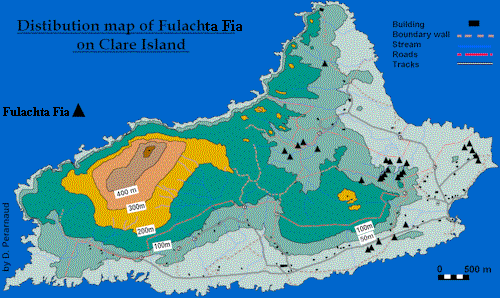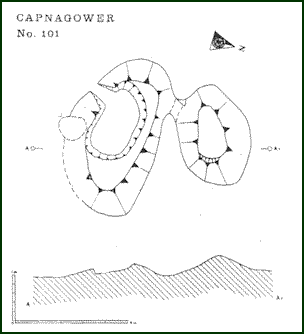| 1. Symposia / Historical Safaris
3. Research 4. Surveys
7. Folklore 9. Contact us 11. Links |
Fulachta Fia
Of these fulachta fia, only 23 survive as intact, or
partially intact, mounds.
Distribution: The distribution of fulachta fia displays a markedly eastern bias. This may, in part, be due to the incomplete nature of the fieldwork, which has yet to be completed for the western part of the island. However, many of the stream and peat basins in the western half of the island, including the Owenmore catchment, have already been subjected to preliminary reconnaissance. The failure to locate even one fulachta fia in these areas was notable. Thus, while the final distribution must await the completion of the fieldwork, the present distribution pattern is unlikely to alter greatly. A number of questions arise regarding the topographical factors which may be affecting the distribution of the fulachta fia on Clare Island. In particular, there is the question of visibility of surviving remains. Of the 24 fulachta fia recorded to date in Lecarrow Townland, for instance, only 12 have any surface remains. The rest have been.uncovered by chance during drainage operations (nine), turf-cutting (one), wall building (one) and animal rubbing (one). Similarly in Glen Townland, all bar one of the ten fulachta now known were brought to light by land reclamation work, principally in the form of drain cutting (six). The exception in this case was again noted in an animal rubbing.
With regard to the Glen sites, it should also be noted that prior to 1989, seven of them were obscured by old spade cultivation ridges. This raises the question that the distribution of fulachta fia, as indeed the distribution of all archaeological monuments on Clare Island, is being heavily distorted by later periods of human activity, and in particular the tillage ridges associated with 18th and 19th century settlement. If this is the case,
then it may go a long way towards explaining the total absence of evidence for prehistoric
settlement along the south side of the island, particularly in the catchment area of the
Owenmore River (Strake Townland) and in the area around Kill to the east of it. Even today, it contains the deepest and most fertile soils on the island. The concentration of settlement activity in this area, and in particular the widespread spade cultivation of the 18th and 19th centuries, may well have obliterated many archaeological monuments including fulachta fia mounds. Siting: Arising from their use of hot stones to heat water, the fulachta fia of Clare Island are obviously to be found close to water sources. However, a study of their siting pattern reveals certain preferences for particular locations. 49% favour locations on the banks of streams or rivers. However, a significant proportion (38%) are also situated in peat basins.
|

